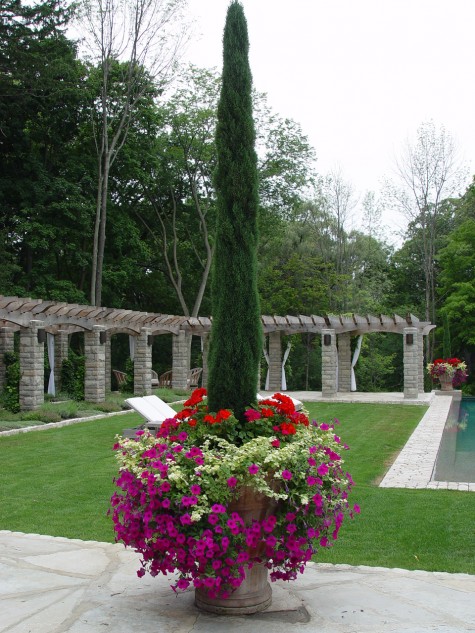 On my top ten list of frequently asked questions, the culture of evergreens in pots ranks right up there. In theory it sounds great. You invest in an evergreen which will provide you with a center of interest that looks great no matter the season. Perhaps there will be room on the edges for a few seasonal annuals. The work and expense up front is considerably more than planting smaller and less expensive plants, but then you are done. Redoing one’s pots with new plants every new season no doubt is a lot of work and expense. But as with everything connected to growing a garden, one is rarely “done”. The Italian cypress in the pot pictured above is not hardy in Michigan, nor can one leave a terra cotta pot such as this one outdoors during the winter. The cypress has to be wintered in a greenhouse cold storage area, and replanted every spring. The pot is put away. There is time and trouble hauling it back to the greenhouse in late fall.
On my top ten list of frequently asked questions, the culture of evergreens in pots ranks right up there. In theory it sounds great. You invest in an evergreen which will provide you with a center of interest that looks great no matter the season. Perhaps there will be room on the edges for a few seasonal annuals. The work and expense up front is considerably more than planting smaller and less expensive plants, but then you are done. Redoing one’s pots with new plants every new season no doubt is a lot of work and expense. But as with everything connected to growing a garden, one is rarely “done”. The Italian cypress in the pot pictured above is not hardy in Michigan, nor can one leave a terra cotta pot such as this one outdoors during the winter. The cypress has to be wintered in a greenhouse cold storage area, and replanted every spring. The pot is put away. There is time and trouble hauling it back to the greenhouse in late fall.
 This 25 year old rosemary has spent 25 winters in a glass house. It is an evergreen-should you live in Greece or Italy, or California. Michigan winters are fiercely cold. However unfair it seems, rosemary is just not hardy here. In return for the extraordinary pleasure of owning an old rosemary such as this one, my client is willing to weather what it takes to keep it alive and healthy.
This 25 year old rosemary has spent 25 winters in a glass house. It is an evergreen-should you live in Greece or Italy, or California. Michigan winters are fiercely cold. However unfair it seems, rosemary is just not hardy here. In return for the extraordinary pleasure of owning an old rosemary such as this one, my client is willing to weather what it takes to keep it alive and healthy.
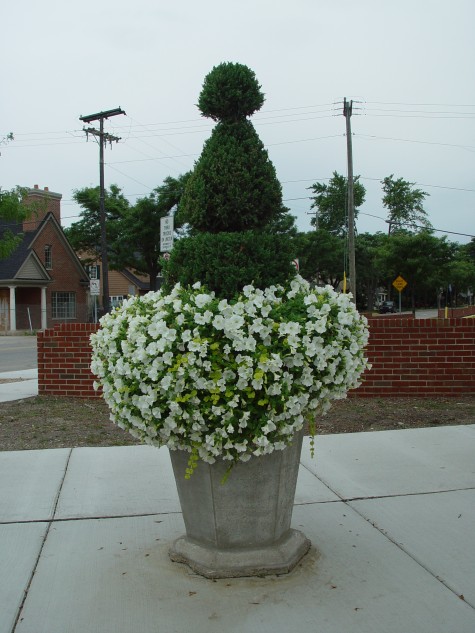 Junipers on the other hand are ruggedly hardy. But key to the successful culture of evergreens in pots is to understand that at best, they tolerate this treatment. Growing a plant in a pot is actually about growing a plant with its roots above ground. No plant likes this-they may or may not put up with it. Siting is the first crucial issue. Evergreens must survive the winter and stay green without being able to take up water. A windy location can dessicate the needles-thus the term, winter burn. A winter burned plant is still alive, but it’s not a good look. It will take time to grow out of the scorched needle phase.
Junipers on the other hand are ruggedly hardy. But key to the successful culture of evergreens in pots is to understand that at best, they tolerate this treatment. Growing a plant in a pot is actually about growing a plant with its roots above ground. No plant likes this-they may or may not put up with it. Siting is the first crucial issue. Evergreens must survive the winter and stay green without being able to take up water. A windy location can dessicate the needles-thus the term, winter burn. A winter burned plant is still alive, but it’s not a good look. It will take time to grow out of the scorched needle phase.
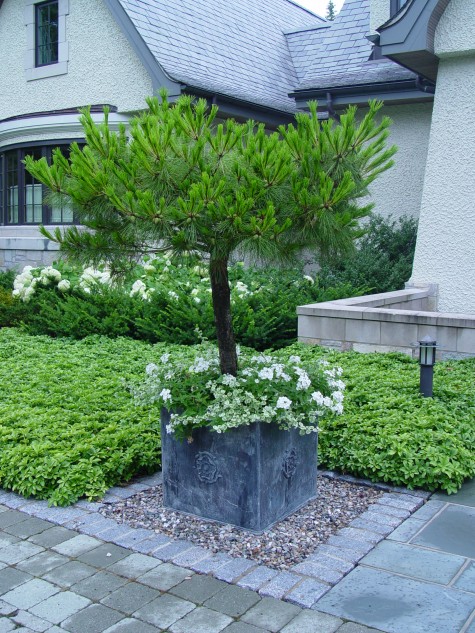 Mugho pines, both the shrubby and the topiary forms, have the reputation of good survivability in pots. Critical to that survival is proper watering. Should you quit watering this evergreen when your geraniums go down from frost, you are almost certain to loose it. Judicious watering right up until the soil ball is frozen solid is a must. If this evergreen were to unfreeze in a January thaw, a watering might be in order. When the soil thaws in the spring, the watering should be resumed-even if this is long before you plant your other pots. What evergreens in containers require is not for the faint of heart.
Mugho pines, both the shrubby and the topiary forms, have the reputation of good survivability in pots. Critical to that survival is proper watering. Should you quit watering this evergreen when your geraniums go down from frost, you are almost certain to loose it. Judicious watering right up until the soil ball is frozen solid is a must. If this evergreen were to unfreeze in a January thaw, a watering might be in order. When the soil thaws in the spring, the watering should be resumed-even if this is long before you plant your other pots. What evergreens in containers require is not for the faint of heart.
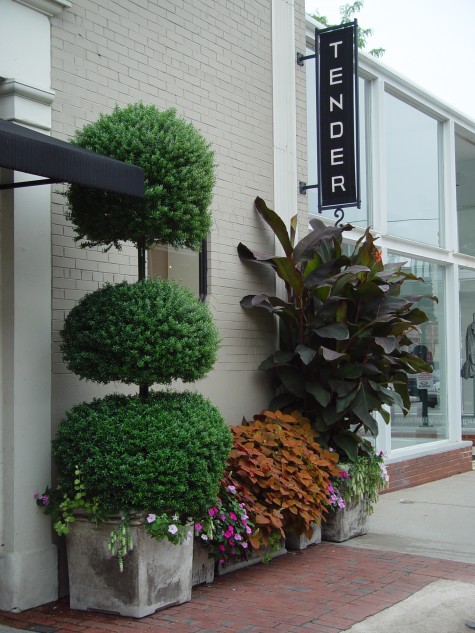 This grand old myrtle topiary was beautifully maintained, for 11 summers. The 12th winter in the greenhouse, a furnace went out, and it froze. It has been in the greenhouse for the past two years; we are trying to coax it back to health. Owning plants like this is a big committment with little in the way of any guarantee. Just because you have provided next to perfect care for a long time does not mean you cannot loose it. Evergreens in containers are for gardeners who relish risk.
This grand old myrtle topiary was beautifully maintained, for 11 summers. The 12th winter in the greenhouse, a furnace went out, and it froze. It has been in the greenhouse for the past two years; we are trying to coax it back to health. Owning plants like this is a big committment with little in the way of any guarantee. Just because you have provided next to perfect care for a long time does not mean you cannot loose it. Evergreens in containers are for gardeners who relish risk.
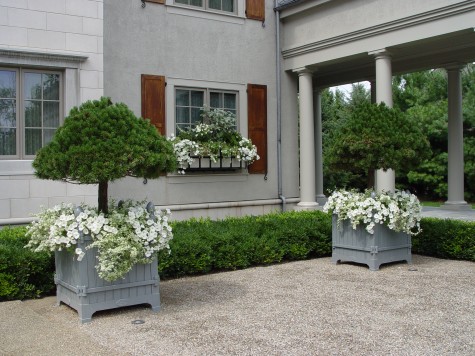 These mugho pines on standard have lived in these orangery boxes for 6 years. At some point, they should be taken out, root pruned, and reset in fresh soil. They will most certainly decline without this maintenance. No plant stays the same, just because its container stays the same. Plants will prosper and grow, or sulk and decline-one or the other.
These mugho pines on standard have lived in these orangery boxes for 6 years. At some point, they should be taken out, root pruned, and reset in fresh soil. They will most certainly decline without this maintenance. No plant stays the same, just because its container stays the same. Plants will prosper and grow, or sulk and decline-one or the other.
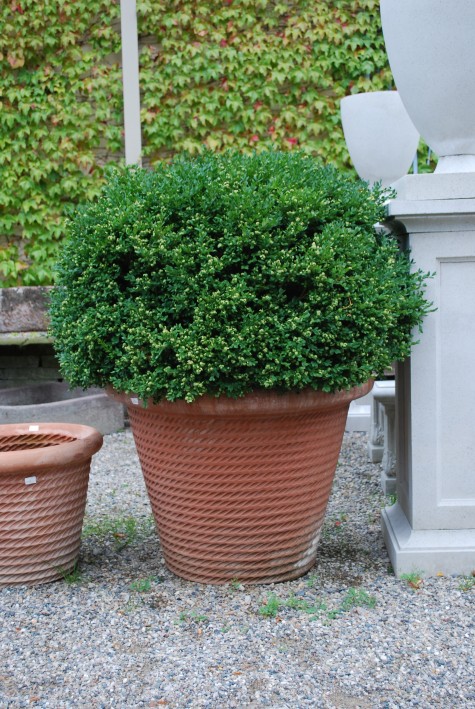 Boxwood is a good choice for a container. As this French terra cotta pot cannot be left out, I wheel this entire assembly into the garage for the winter. This species, Buxus Microphylla, is very tough; my hedge on the southside of my building never winter burns. In the same spirit, it tolerates a mostly dark and unheated garage from November until March. At the first sign of moderating temperatures, I take it back outside. A garage can get too warm for holding plants dormant long before the outside temperatures moderate.
Boxwood is a good choice for a container. As this French terra cotta pot cannot be left out, I wheel this entire assembly into the garage for the winter. This species, Buxus Microphylla, is very tough; my hedge on the southside of my building never winter burns. In the same spirit, it tolerates a mostly dark and unheated garage from November until March. At the first sign of moderating temperatures, I take it back outside. A garage can get too warm for holding plants dormant long before the outside temperatures moderate.
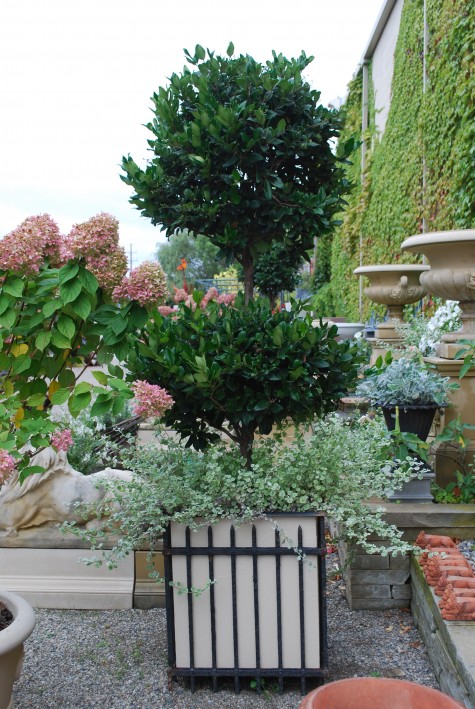 Waxleaf privets are an aristocratic cousin of our hardy privet. The large leaves are lustrous and juicy looking. They are hardy in zone 7, so they can be wintered in an indoor spot without much in the way of heat. They grow slowly, and are available in big sizes; there is demand for the topiary forms from gardeners in more temperate regions. They take well to pruning and shaping.
Waxleaf privets are an aristocratic cousin of our hardy privet. The large leaves are lustrous and juicy looking. They are hardy in zone 7, so they can be wintered in an indoor spot without much in the way of heat. They grow slowly, and are available in big sizes; there is demand for the topiary forms from gardeners in more temperate regions. They take well to pruning and shaping.
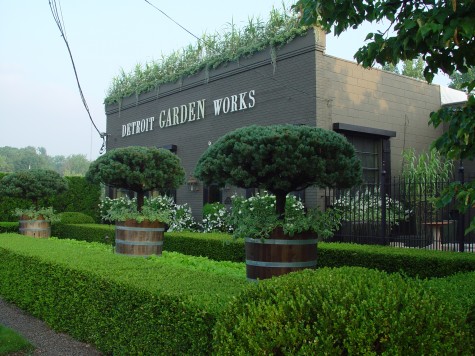
These giant scotch pine on standard are breathtakingly beautiful. I kept them in equally giant wood barrels for the better part of two years, before I sold them. Evergreens need big rootballs to insure successful transplanting-so pots for evergreens need to be large. Boxwood balls are usually larger than their foliage diameter. A well-grown evergreen in a gorgeous container is hard to beat; most likely I will keep on trying to grow them.

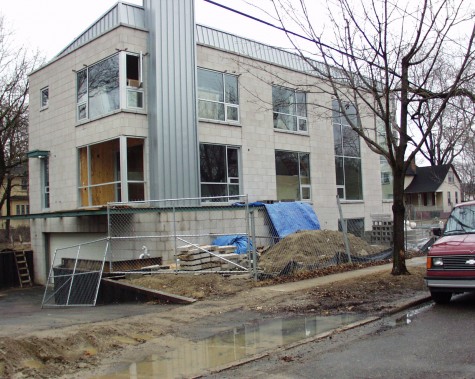 Luckily glass reflects light during the day. Her life would not be on visual review from all the neighboring properties-except at night. Given the very small size of the lot, the architect had designed a basement garage accessible from a sharply pitched drive. I did admire how he managed to exclude the garage from the visual presentation of the of the house. The garage is rarely the most beautiful feature of a home. It was necessary to retain the soil surrounding the house in order to permit a drive surface below grade. This was accomplished cleanly with corrugated steel capped in corten.
Luckily glass reflects light during the day. Her life would not be on visual review from all the neighboring properties-except at night. Given the very small size of the lot, the architect had designed a basement garage accessible from a sharply pitched drive. I did admire how he managed to exclude the garage from the visual presentation of the of the house. The garage is rarely the most beautiful feature of a home. It was necessary to retain the soil surrounding the house in order to permit a drive surface below grade. This was accomplished cleanly with corrugated steel capped in corten. The house is very tall, and the stone and glass edifice is starkly contemporary. The land unoccupied by the house amounted to an L-shaped strip barely wider than the right of way between the street and the sidewalk. Some homes are architecturally demanding buildings. By this I mean their sculptural element dominates the space. My client has a big love for contemporary art and architecture-such that the prospect of living in a sculpture appealed to her. It was my job to design a landscape that would in no way interfere with the one thought-the sculpture that would also provide a home to her. This landscape would in no way be about plants; it needed to be about sculpture too.
The house is very tall, and the stone and glass edifice is starkly contemporary. The land unoccupied by the house amounted to an L-shaped strip barely wider than the right of way between the street and the sidewalk. Some homes are architecturally demanding buildings. By this I mean their sculptural element dominates the space. My client has a big love for contemporary art and architecture-such that the prospect of living in a sculpture appealed to her. It was my job to design a landscape that would in no way interfere with the one thought-the sculpture that would also provide a home to her. This landscape would in no way be about plants; it needed to be about sculpture too.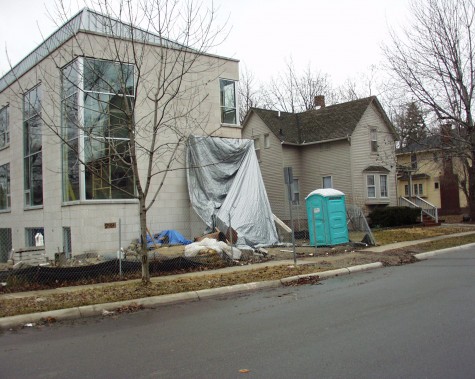 The slanted steel roof presented its own problem-how to handle rain water. A drainage system was designed, and approved by the city. It was very expensive, but it prevented water from flooding the neighboring property. The front porch under construction here would necessitate a big flight of steps, as the bottom of the glass panels matched the grade of the first floor living space.
The slanted steel roof presented its own problem-how to handle rain water. A drainage system was designed, and approved by the city. It was very expensive, but it prevented water from flooding the neighboring property. The front porch under construction here would necessitate a big flight of steps, as the bottom of the glass panels matched the grade of the first floor living space. 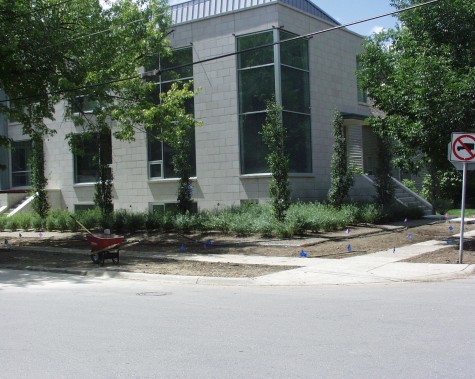 As with any contemporary landscape, a restricted palette of materials makes for a clean and strong statement. I planted a slew of Salix purpurea nana-commonly known as dwarf actic willow. Its gracefully meadow-like appearance sharply contrasted to the hard surfaces of the house, and softened them. The blocks of willows would be mulched in granite gravel. The columnar poplars would not obstruct the views of the house, but would slightly break up the stone and glass surface. The placement was dictated in part to provide good views from the inside of the trees outdoors.
As with any contemporary landscape, a restricted palette of materials makes for a clean and strong statement. I planted a slew of Salix purpurea nana-commonly known as dwarf actic willow. Its gracefully meadow-like appearance sharply contrasted to the hard surfaces of the house, and softened them. The blocks of willows would be mulched in granite gravel. The columnar poplars would not obstruct the views of the house, but would slightly break up the stone and glass surface. The placement was dictated in part to provide good views from the inside of the trees outdoors. 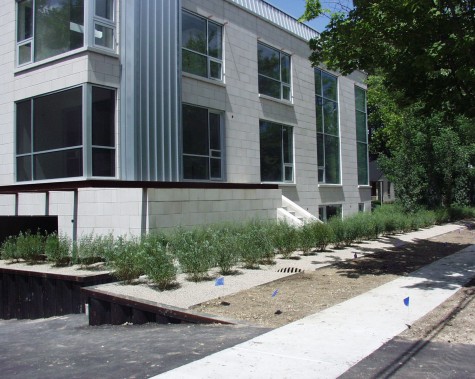 The transition from the willows to the walk would be handled by lawn. It was important for a house this size to visually include the right of way landscape, so more lawn was in order.
The transition from the willows to the walk would be handled by lawn. It was important for a house this size to visually include the right of way landscape, so more lawn was in order. 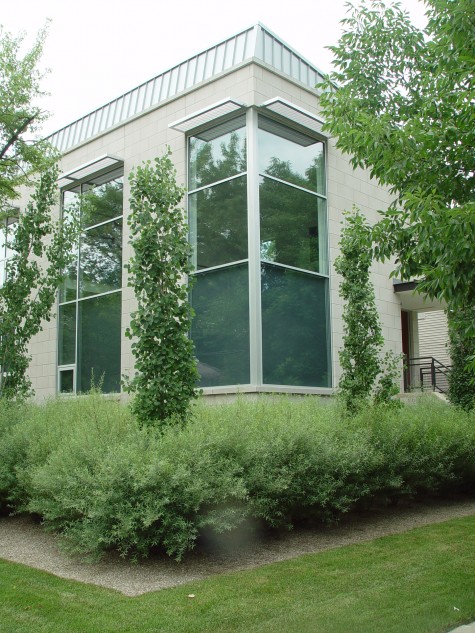 Given some time, the willows took hold. Their dense billowing appearance is simple and handsome. These densely twiggy shrubs are solid and graceful. Their mature height barely sweeps the bottom of the glass panels. Their slightly bluish cast repeated the blue-green color of the poplar leaves.
Given some time, the willows took hold. Their dense billowing appearance is simple and handsome. These densely twiggy shrubs are solid and graceful. Their mature height barely sweeps the bottom of the glass panels. Their slightly bluish cast repeated the blue-green color of the poplar leaves.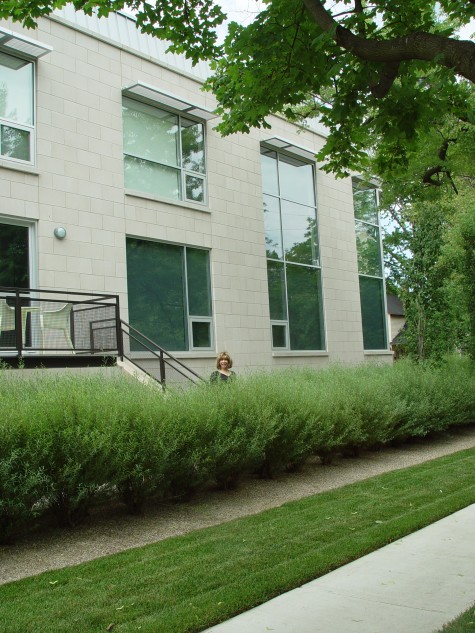 The walkway to the side door is embedded in this meadow as well. A retaining wall which permitted windows to be installed at the basement level is no longer visible-as the wall is strictly utilitarian, we screened it from view. The look of a shrubby willow reminds me of an ornamental grass. Ornamental grasses are difficult in the winter season. Leave them tall over the winter-heavy snow will knock them over, and spring winds will scatter their broken branches everywhere. Trimmed to the ground in the fall-that look is not so appealing either. Some prominent places in a landscape wanting grasses might benefit from being shrubbed up with dwarf willows.
The walkway to the side door is embedded in this meadow as well. A retaining wall which permitted windows to be installed at the basement level is no longer visible-as the wall is strictly utilitarian, we screened it from view. The look of a shrubby willow reminds me of an ornamental grass. Ornamental grasses are difficult in the winter season. Leave them tall over the winter-heavy snow will knock them over, and spring winds will scatter their broken branches everywhere. Trimmed to the ground in the fall-that look is not so appealing either. Some prominent places in a landscape wanting grasses might benefit from being shrubbed up with dwarf willows. 
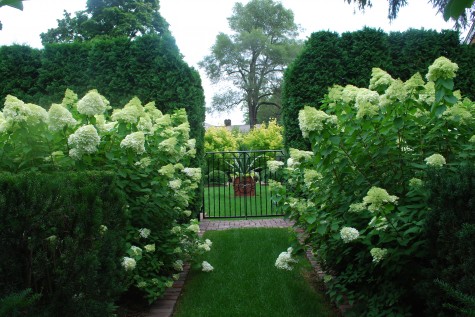
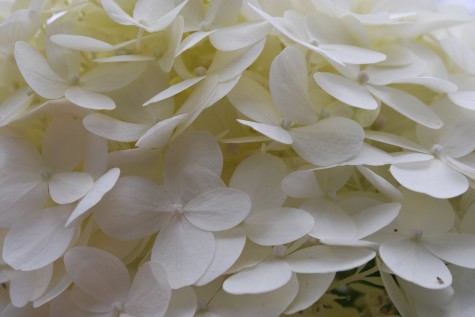
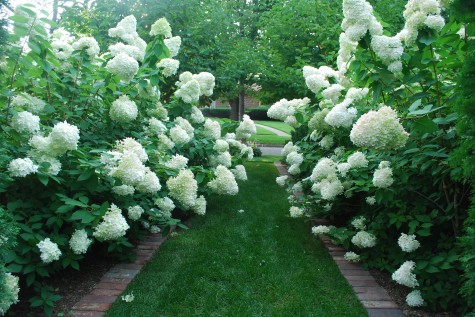
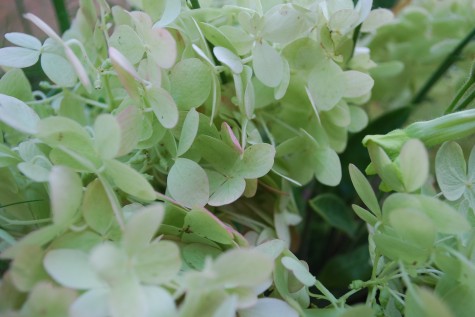

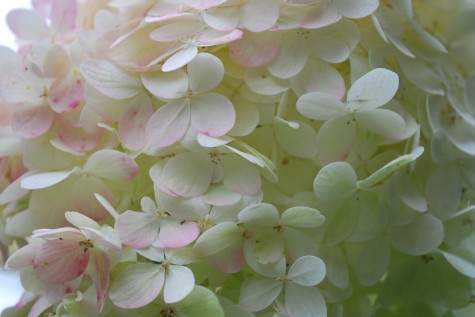
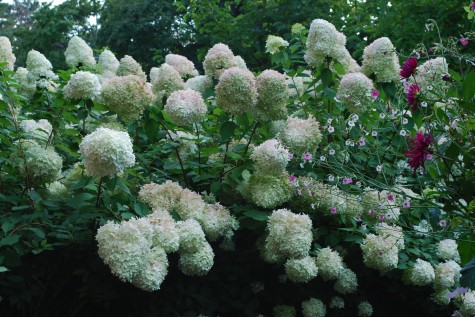
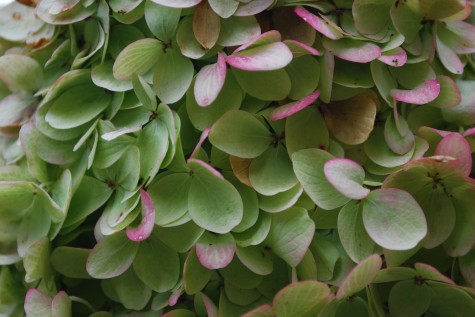
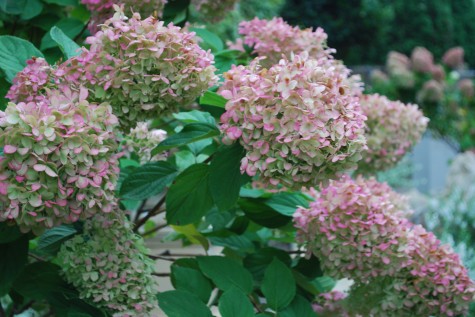
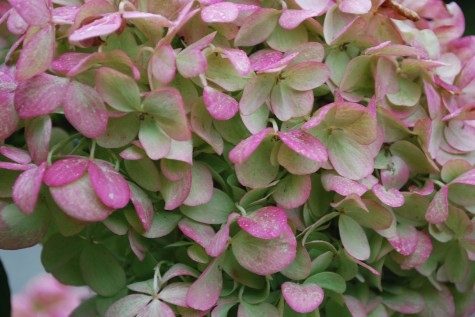

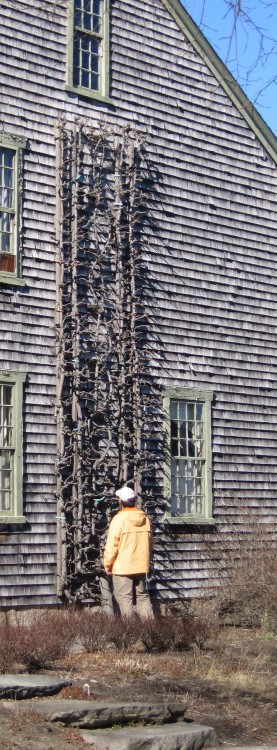 Would not the silhouette of this tree, trained and grown parallel to a wall, get your attention? Even out of leaf, it is striking. You are looking at an espalier- a tree trained to grow in only two dimensions. In the late 1600’s, Fr. Legendre, a monk living in Hanonville France was in charge of his monastery’s garden. His fruit trees were bedevilled by late frosts that killed the fruiting buds. Noticing that the fruit trees planted closest to the monastery walls sustained the least damage, he began planting his fruit trees as close to the walls as possible. As wall space was limited, he began shearing his trees, so as to provide room for all the varieties he wanted to grow. Amazingly, the drastically sheared trees produced heavier yields than unpruned trees in the field. His book, Palmette Legendre, was published shortly before his death in 1684. This book is the earliest known text regarding the science of growing espaliers. These trees, pruned flat, spare, and parallel to a wall, had fewer cultural problems, took up little space, and were beautiful to boot.
Would not the silhouette of this tree, trained and grown parallel to a wall, get your attention? Even out of leaf, it is striking. You are looking at an espalier- a tree trained to grow in only two dimensions. In the late 1600’s, Fr. Legendre, a monk living in Hanonville France was in charge of his monastery’s garden. His fruit trees were bedevilled by late frosts that killed the fruiting buds. Noticing that the fruit trees planted closest to the monastery walls sustained the least damage, he began planting his fruit trees as close to the walls as possible. As wall space was limited, he began shearing his trees, so as to provide room for all the varieties he wanted to grow. Amazingly, the drastically sheared trees produced heavier yields than unpruned trees in the field. His book, Palmette Legendre, was published shortly before his death in 1684. This book is the earliest known text regarding the science of growing espaliers. These trees, pruned flat, spare, and parallel to a wall, had fewer cultural problems, took up little space, and were beautiful to boot.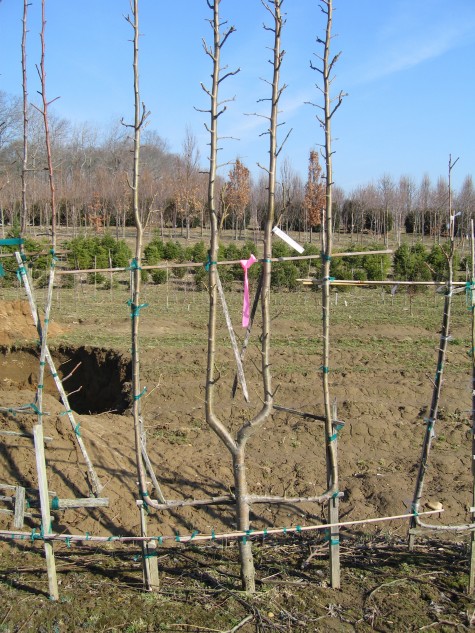 Espaliered fruit trees look like no naturally growing tree . Though no tree expert would advise this kind of planting, pruning and shaping, Father Legendre’s ideas practices enabled ample fruit for everyone living at his monastery. Sometimes the hand of man comes to good end in the environment. This very early spring picture shows an espaliered tree, grown in the candelabra shape. It would be beautiful, grown on a blank wall-never mind the fruit. Training trees to grow in two dimensions became a gardening art form-even for those who had no need to feed many from a very small plot of land.
Espaliered fruit trees look like no naturally growing tree . Though no tree expert would advise this kind of planting, pruning and shaping, Father Legendre’s ideas practices enabled ample fruit for everyone living at his monastery. Sometimes the hand of man comes to good end in the environment. This very early spring picture shows an espaliered tree, grown in the candelabra shape. It would be beautiful, grown on a blank wall-never mind the fruit. Training trees to grow in two dimensions became a gardening art form-even for those who had no need to feed many from a very small plot of land. 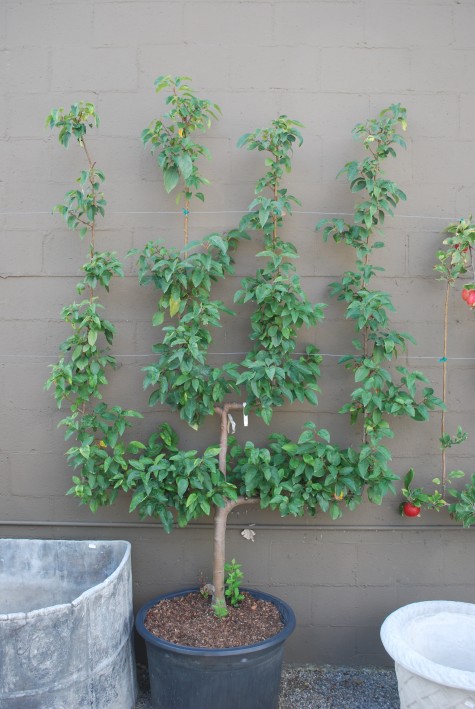 I make a special effort to offer exceptional espaliered trees to my clients. My grower of choice is of French descent, and his espaliers take my breath away. I drive a day’s length to see and review his espaliers. He grows in the traditional way, and only has a few trees to offer for sale every year. He sells no trees that are not at least seven years old; his big trees are much older. He pots his trees, and then sinks the pots in the ground. Note that the trunk of this tree is positioned to the back of its pots-his trees are easy to plant close to a wall.
I make a special effort to offer exceptional espaliered trees to my clients. My grower of choice is of French descent, and his espaliers take my breath away. I drive a day’s length to see and review his espaliers. He grows in the traditional way, and only has a few trees to offer for sale every year. He sells no trees that are not at least seven years old; his big trees are much older. He pots his trees, and then sinks the pots in the ground. Note that the trunk of this tree is positioned to the back of its pots-his trees are easy to plant close to a wall. 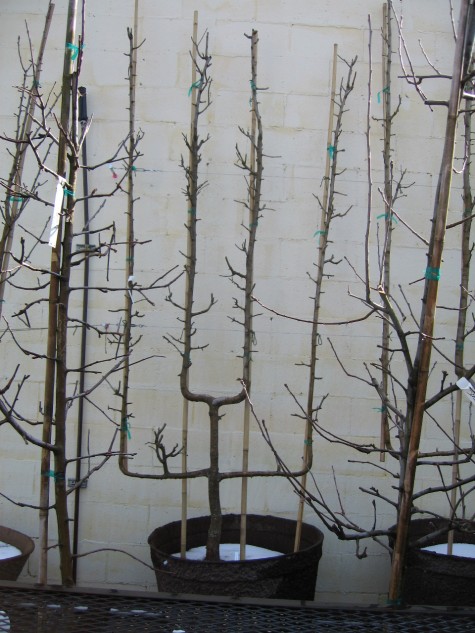 Their winter appearance is architectural. The American landscape is fundamentally based on big spaces; we have eight lane highways and driveways 22 feet wide. This makes this particular dose of French editing all the more refreshing. People who come to my store are invariably interested in their history and forms.
Their winter appearance is architectural. The American landscape is fundamentally based on big spaces; we have eight lane highways and driveways 22 feet wide. This makes this particular dose of French editing all the more refreshing. People who come to my store are invariably interested in their history and forms. My grower trains some of his espaliers in a form not existing in the classical literature. This framed heart is entirely his invention; how I love this. It has a distinctly American feeling; he has taken his classical training, and gone beyond.
My grower trains some of his espaliers in a form not existing in the classical literature. This framed heart is entirely his invention; how I love this. It has a distinctly American feeling; he has taken his classical training, and gone beyond. 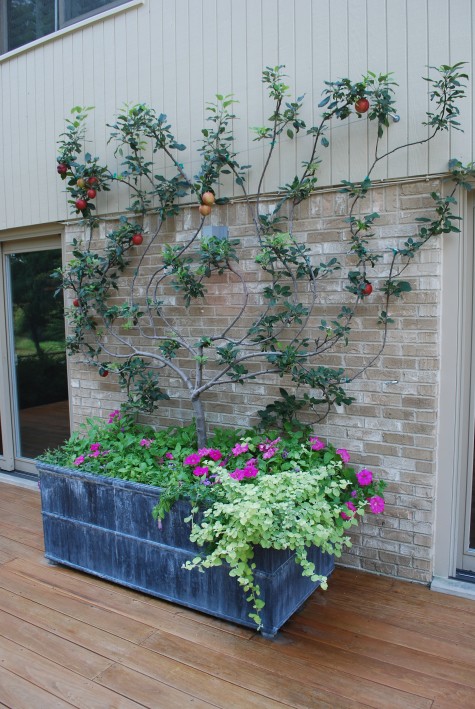 This informal heart espalier enchanted one of my clients. I call it the wild at heart espalier. As she had no room in the ground, we built her a box for her deck, insulated to slow the freeze, and delay the spring thaw; this apple tree is thriving. We heap up the compost after the ground freezes, and we uncover it in the spring; so far, so good.
This informal heart espalier enchanted one of my clients. I call it the wild at heart espalier. As she had no room in the ground, we built her a box for her deck, insulated to slow the freeze, and delay the spring thaw; this apple tree is thriving. We heap up the compost after the ground freezes, and we uncover it in the spring; so far, so good.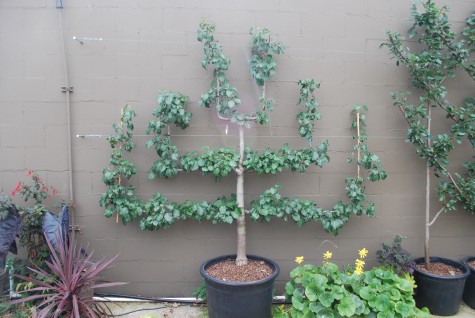 Not all espaliers are fruit trees. The art of training espaliered trees has extended to many trees tolerant of this treatment. This Bradford pear makes a big statement as an espalier. Any lonely wall would be all the happier for this tree planted on it.
Not all espaliers are fruit trees. The art of training espaliered trees has extended to many trees tolerant of this treatment. This Bradford pear makes a big statement as an espalier. Any lonely wall would be all the happier for this tree planted on it.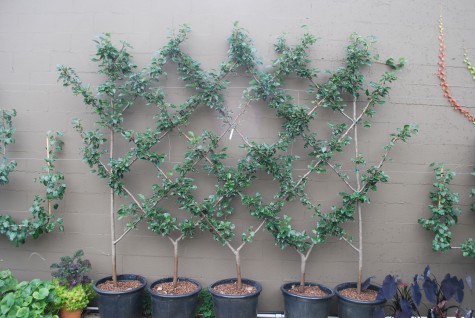 This series of trees is known as a Belgian Fence. You can see that individual trees were topped low to the ground as whips, encouraging branching in both directions. The branches of these trees are trained in a diamond pattern; what a beautiful living ornament for a long wall, or a free standing fence.
This series of trees is known as a Belgian Fence. You can see that individual trees were topped low to the ground as whips, encouraging branching in both directions. The branches of these trees are trained in a diamond pattern; what a beautiful living ornament for a long wall, or a free standing fence.